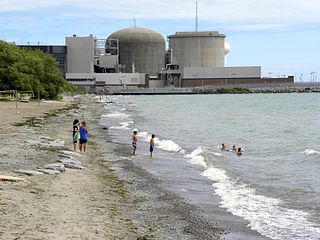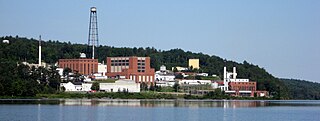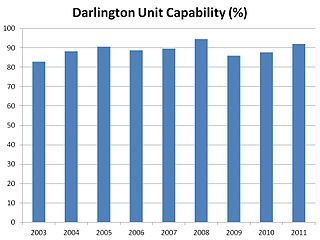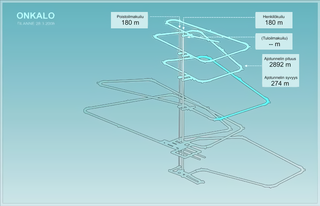Related Research Articles

Pickering Nuclear Generating Station is a Canadian nuclear power station located on the north shore of Lake Ontario in Pickering, Ontario. It is one of the oldest nuclear power stations in the world and Canada's third-largest, with eight CANDU reactors. Since 2003, two of these units have been defueled and deactivated. The remaining six produce about 16% of Ontario's power and employ 3,000 workers.

Chalk River Laboratories is a Canadian nuclear research facility in Deep River, about 180 km (110 mi) north-west of Ottawa.
Atomic Energy of Canada Limited (AECL) is a Canadian federal Crown corporation and Canada's largest nuclear science and technology laboratory. AECL developed the CANDU reactor technology starting in the 1950s, and in October 2011 licensed this technology to Candu Energy.

Darlington Nuclear Generating Station is a Canadian nuclear power station located on the north shore of Lake Ontario in Clarington, Ontario. It is a large nuclear facility comprising four CANDU nuclear reactors with a total output of 3,512 MWe when all units are online, providing about 20 percent of Ontario's electricity needs, enough to serve a city of two million people. The reactor design is significantly more powerful than those used in previous CANDU sites at Pickering and Bruce, making its 4-unit plant the second-largest in Canada behind the 8-unit Bruce. It is named for the Township of Darlington, the name of the municipality in which it is located, which is now part of the amalgamated Municipality of Clarington.

The SLOWPOKE is a family of low-energy, tank-in-pool type nuclear research reactors designed by Atomic Energy of Canada Limited (AECL) beginning in the late 1960s. John W. Hilborn is the scientist most closely associated with their design. They are beryllium-reflected with a very low critical mass, but provide neutron fluxes higher than available from a small particle accelerator or other radioactive sources.
The Whiteshell Laboratories, originally known as the Whiteshell Nuclear Research Establishment (WNRE) was an Atomic Energy of Canada (AECL) laboratory in Manitoba, northeast of Winnipeg. It was originally built as a home for the experimental WR-1 reactor, but over time came to host a variety of experimental systems, including a SLOWPOKE reactor and the Underground Research Laboratory to study nuclear waste disposal. Employment peaked in the early 1970s at about 1,300, but during the 1980s the experiments began to wind down, and in 2003 the decision was made to close the site. As of 2017 the site is undergoing decommissioning with a planned completion date in 2024. The decommissioning process for WR-1 involves transporting low-level nuclear waste to another Canadian Nuclear Laboratories (CNL) research site, Chalk River Laboratories in Ottawa for containment, and encasing the reactor in concrete. The details of this process continue to be criticized, evaluated, and revised.

The Nuclear Waste Policy Act of 1982 is a United States federal law which established a comprehensive national program for the safe, permanent disposal of highly radioactive wastes.
Nuclear Power Demonstration was the first Canadian nuclear power reactor, and the prototype for the CANDU reactor design. Built by Canadian General Electric, in partnership with Atomic Energy of Canada Limited (AECL) and the Hydro Electric Power Commission of Ontario it consisted of a single 22 MWe pressurized heavy water reactor (PHWR) unit located in Rolphton, Ontario, not far from AECL's Chalk River Laboratories. NPD was owned by AECL and operated by Ontario Hydro.
Nuclear power in Canada is provided by 19 commercial reactors with a net capacity of 13.5 gigawatt (GW), producing a total of 95.6 terawatt-hours (TWh) of electricity, which accounted for 16.6% of the country's total electric energy generation in 2015. All but one of these reactors are located in Ontario, where they produced 61% of the province's electricity in 2019. Seven smaller reactors are used for research and to produce radiopharmaceuticals for use in nuclear medicine.
The Whiteshell Reactor No. 1, or WR-1, was a Canadian research reactor located at AECL's Whiteshell Laboratories (WNRL) in Manitoba. Originally known as Organic-Cooled Deuterium-Reactor Experiment (OCDRE), it was built to test the concept of a CANDU-type reactor that replaced the heavy water coolant with an oil substance. This had a number of potential advantages in terms of cost and efficiency.

A deep geological repository is a way of storing hazardous or radioactive waste within a stable geologic environment, typically 200–1,000 m deep. It entails a combination of waste form, waste package, engineered seals and geology that is suited to provide a high level of long-term isolation and containment without future maintenance. This will prevent any radioactive dangers. A number of mercury, cyanide and arsenic waste repositories are operating worldwide including Canada and Germany. Radioactive waste storage sites are under construction with the Onkalo in Finland being the most advanced.

The Meuse/Haute Marne Underground Research Laboratory is a laboratory located 500 metres underground in Bure in the Meuse département. It allows study of the geological formation in order to evaluate its capacity for deep geological repository of high-level and long-lived medium-level radioactive waste. It is managed by the National Agency for the Management of Radioactive Waste or ANDRA.

Madawaska Mine (previously known as Faraday Mine) is a decommissioned underground uranium mine in Faraday, near the town of Bancroft, Ontario, which produced 9 million pounds (4,082 tonnes) of U3O8 concentrate, at an average ore grade of 0.1074%, during its two periods of production.

Ontario Power Generation Inc. (OPG) is a Crown corporation and "government business enterprise" that is responsible for approximately half of the electricity generation in the province of Ontario, Canada. It is wholly owned by the government of Ontario. Sources of electricity include nuclear, hydroelectric, wind, gas and biomass. Although Ontario has an open electricity market, the provincial government, as OPG's sole shareholder, regulates the price the company receives for its electricity to be less than the market average, in an attempt to stabilize prices. Since 1 April 2008, the company's rates have been regulated by the Ontario Energy Board.

High-level radioactive waste management addresses the handling of radioactive materials generated from nuclear power production and nuclear weapons manufacture. Radioactive waste contains both short-lived and long-lived radionuclides, as well as non-radioactive nuclides. In 2002, the United States stored approximately 47,000 tonnes of high-level radioactive waste.
The Deep Geologic Repository Project (DGR) was a proposal by Ontario Power Generation (OPG) in 2002 for the site preparation, construction, operation, decommissioning and abandonment of a deep geological radioactive waste disposal facility for low and intermediate-level radioactive waste (L&ILW). In 2005, the municipality of Kincardine, Ontario volunteered to host the facility located on the Bruce nuclear generating station adjacent to OPG's Western Waste Management Facility (WWMF). The facility would have managed L&ILW produced from the continued operation of OPG-owned nuclear generating stations at the Bruce, Pickering Nuclear Generating Station and Darlington Nuclear Generating Station in Ontario. In May 2020, after 15 years of environmental assessment, OPG withdrew its application for a construction license on Saugeen Ojibway Nation Territory.

Nuclear industry in Canada is an active business and research sector, producing about 15% of its electricity in nuclear power plants of domestic design. Canada is the world's largest exporter of uranium, and has the world's second largest proven reserves. Canada also exports nuclear technology within the terms of the Nuclear Non-proliferation Treaty, to which it is a signatory, and is the world's largest producer of radioactive medical isotopes.

The Onkalo spent nuclear fuel repository is a deep geological repository for the final disposal of spent nuclear fuel. It is near the Olkiluoto Nuclear Power Plant in the municipality of Eurajoki, on the west coast of Finland. It will be the world's first long-term disposal facility for spent nuclear fuel. It is being constructed by Posiva, and is based on the KBS-3 method of nuclear waste burial developed in Sweden by Svensk Kärnbränslehantering AB (SKB). The facility is expected to be operational in the mid 2020s.
The Beishan Underground Research Laboratory is a deep geological repository for the disposal of spent nuclear fuel, currently under construction in the Gobi Desert, in Gansu, China. The facility is expected to take 7 years to build, with a planned operating period of 50 years, and cost approximately 2.7 billion yuan. It will reach 560 m (1,840 ft) below ground at its deepest point.

Uranium mining around Bancroft, Ontario, was conducted at four sites, beginning in the early 1950s and concluding by 1982. Bancroft was one of two major uranium-producing areas in Ontario, and one of seven in Canada, all located along the edge of the Canadian Shield. In the context of mining, the "Bancroft area" includes Haliburton, Hastings, and Renfrew counties, and all areas between Minden and Lake Clear. Activity in the mid-1950s was described by engineer A. S. Bayne in a 1977 report as the "greatest uranium prospecting rush in the world".
References
Citations
- 1 2 3 CNSC Repo 2016.
- 1 2 Chandler 2003, p. 3.
- ↑ Chandler 2003, p. 2.
- 1 2 Chandler 2003, p. 1.
- 1 2 3 Chandler 2003, p. 4.
- 1 2 3 Chandler 2003, p. 6.
- 1 2 3 Redekop 2003.
- 1 2 Chandler 2003, p. 7.
- ↑ "Underground Research Laboratory (URL)". University of Toronto Civil & Mineral Engineering.
- ↑ Owen 2010.
- ↑ Chandler 2003, p. Figure 2.
Bibliography
- Chandler, N. A. (February 2003). Twenty Years of Underground Research at Canada's URL (PDF) (Technical report). WM’03 Conference.
- Owen, Bruce (8 December 2010). "Whiteshell labs closes underground facility forever". Winnipeg Free Press.
- "CNSC research on geological repositories". Canadian Nuclear Safety Commission. 24 October 2016.
- Redekop, Bill (18 May 2003). "Closing of $40-M lab shocks Pinawa area". Winnipeg Free Press.